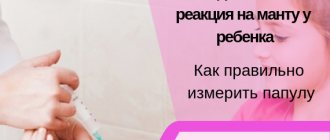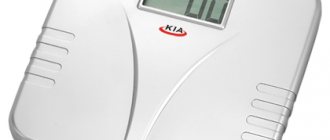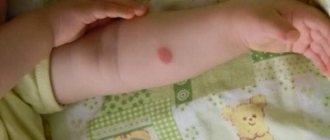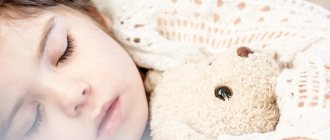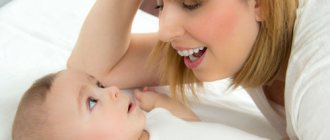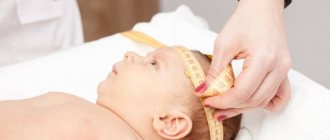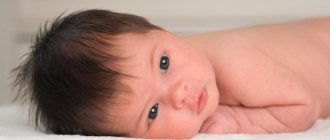With the arrival of a newborn baby in the house, parents have new worries: to provide the most comfortable conditions for their baby. Choosing the optimal temperature in the baby's room is of great importance. However, that's not all! The baby's well-being is also affected by the humidity in the newborn room. If there is enough of it, then the metabolic processes in the baby’s body will proceed more actively, and as a result, he will grow faster and get sick less. Lack of air humidity can lead to frequent colds, runny nose, allergies and even asthma. Therefore, all mothers and fathers should know what humidity should be in a newborn’s room.
What humidity should be in a nursery?
Skin rashes, periodic coughing, sniffling - all these signs may not be cold symptoms at all, but a consequence of high or low humidity in the room. When exhaling, the air inhaled by the baby becomes 100% moist. If the humidity in the room is below 50%, then the child’s body will release moisture, and this leads to fluid loss. If a child consumes a small amount of liquid, dehydration may result.
In autumn and spring, the air humidity in the apartment is mostly normal. And in summer and winter it needs to be increased a little, because at these times of the year the air is drier. The following will help normalize the indicators:
- wet cleaning once a day;
- installing containers filled with liquid near heating devices and near the place where the child is most often located;
- ultrasonic or steam humidifier;
By controlling the temperature and humidity in the room, you can reduce the incidence of acute respiratory viral infections. The correct microclimate has a positive effect on the growth, development and well-being of the baby. However, before humidifying the air, it is necessary to measure the humidity, since high levels are also not desirable.
The children's body is structured a little differently; in children, all processes in the body go much faster than in adults. Thermoregulation in children is carried out through the skin and respiratory organs, and it is not perfect. The recommended room temperature for children is 18-20 degrees Celsius. During the day, while you are awake, it can reach 21-22 degrees, but during sleep it is better to lower it to 18 degrees. Do not forget about ventilation, it is carried out 2-3 times a day. It is better to ventilate the apartment during walks, as well as before going to bed. The correct microclimate improves:
- appetite;
- mood;
- general well-being;
On a note!
Newborns have poorly developed sweat glands.
The recommended air humidity in an apartment or house for a child should be from 50 to 70%. This can be determined using a device called a hygrometer. It is sold in hardware stores. You can also use Magik Air - this is a smart microclimate system, you can even control it with the help of gadgets.
What does a decrease in air humidity in a newborn’s room below normal lead to?
All newborn babies suffer from low humidity; this parameter does not have such a detrimental effect on adults. Lack of moisture primarily manifests itself in:
- Drying of the skin surface. It becomes warm and damp and loses its protective properties. Because of this, pathogens can enter the baby's body.
- Frequent coughing. The child feels dry mucous membranes, so he may cough often, feel dry mouth, and the baby develops a runny nose.
- Blood thickening. Lack of moisture in newborns also affects this parameter.
Dry, hot air in the room contributes to the accumulation of harmful microorganisms in the nursery, dust and allergens. As a result, the risk of allergic reactions and even asthma increases.
How to humidify the air
Many ways have been invented for this. The most effective is to buy a humidifier, they come in several types, one of the best is ultrasonic, it is almost silent and gets the job done faster. However, it is not always possible to buy it, and then folk methods will come to the rescue:
- A wet sheet - it is hung on the radiator, and when it dries, it is replaced with another one.
- A container of water is placed near the battery.
- A plastic bottle with a hole cut out in the middle is hung on the battery and filled with water. Afterwards, take several pieces of fabric, gauze or bandage, lower one end into water, and tie the other to the battery.
- Vessels with water can also be placed on furniture, the effect will be less noticeable, but it will be there.
What to do if the temperature and humidity in the newborn’s room differ sharply from the norm
To bring the humidity parameters up to normal, experts advise using special devices or improvised means:
- Humidifier. The most proven method, a silent device will very quickly fill the room with cold, damp air, but not steam! Some models have the function of ionizing the room or spraying special aromatic oils.
- Wet cleaning of the premises. And it will get rid of dust and significantly moisturize the air in the nursery.
- Availability of open water tanks. It can be anything: from basins to decorative fountains and aquariums.
- Spraying moisture with a spray bottle.
- Drying wet towels on radiators. The least productive method, as it fills the room with hot steam.
How to reduce air humidity
High humidity also adversely affects the development and health of the baby. After all, due to dampness, the temperature in the apartment decreases. Also, in a damp room, an unpleasant odor appears and a fungal coating may form on the walls or furniture. And through the respiratory system, toxic substances enter the lungs. The child usually begins to get colds more often. Therefore, high humidity also needs to be dealt with.
To normalize indicators, you first need to identify the reason for their increase. Often the source of moisture is an external wall. You can conduct a small experiment: a piece of glass is applied to the wall, and if condensation has formed between it and the wall, then the source has been found. In this case, the outer wall must be insulated using vapor-permeable materials. It is also necessary to better heat an apartment or house, and for this you may need additional heat sources (heater or convector). If the humidity rises periodically, it is advisable to follow the following recommendations:
- ventilate the room three times a day;
- insulate window openings;
- eliminate draft sources (floor, walls)
- install moisture absorbers or dehumidifiers;
What to do if the room is too dry for the baby?
There are several ways to humidify the air so as not to spoil your baby's health.
Ultrasonic humidifiers - in the store you can find many inexpensive and effective models, even for 1000 rubles. But you should not use such humidifiers in children's rooms if the water that enters the device is not first purified through a filter. In addition, water must be added regularly.
Nozzle humidifiers are an ideal option for a baby’s room. They consume little energy, supply water from the tap into the system automatically and are easy to maintain.
The worst option for a child's room is steam humidifiers . They have many shortcomings. Firstly, they heat the air, which should be cool in the room where the child lives. Secondly, they consume a lot of electricity. Thirdly, the devices are dangerous for children. Steam appliances heat water, like electric kettles, and spray it around. When a child learns to move independently, there is a risk that he will want to get to the equipment, try to disassemble it and get burned.
How to Maintain Humidity Levels for a Newborn
It is believed that the temperature in a baby’s room should vary from 18 to 20 degrees. It should be remembered that each child is individual, and the temperature in the room should be adjusted depending on the child’s behavior and well-being. Many mothers and grandmothers, having arrived from the maternity hospital, wrap up their babies, while turning on all kinds of heating means. This is not correct, because they dry the air, and as a result, the baby may experience:
- increased body temperature (a common occurrence with overheating);
- bloating;
- difficulty breathing due to dry mucous membranes;
On a note!
Premature babies need warmth, 18-20 degrees for them is a low temperature.
To monitor the thermometer readings, you need to hang a thermometer next to the crib. In winter, to reduce the indicators, the room is ventilated; it is better to do this while walking. In summer, the temperature in the room can be adjusted using an air conditioner, but it is better to do this also without a child in the room. In hot weather, you need to water and bathe your baby more often, this will help prevent dehydration.
What are the dangers of overheating and hypothermia?
One of the main features of a baby is the high rate of metabolic processes in his body, even during sleep. During metabolism, a certain amount of heat is released, which requires release into the environment.
In the human body, heat exchange occurs in two ways - through the respiratory system and through sweating:
1. In the first case, the child breathes air whose temperature is lower than body temperature.
Air masses, having passed through the “air duct” and the lungs, begin to heat up in order to carry away excess heat with exhalation. If the air temperature is significantly lower than the child’s temperature, then heat transfer increases.
2. The process of sweating is also important for the functioning of the human body. The increased temperature “blocks” the respiratory mechanism, which is why sweating is activated.
The excretory system of the baby produces fluids that come out onto the skin and remove salts necessary for the body.
As a result, the child begins to overheat, the symptoms of which are:
- drying of saliva, which can lead to candidiasis (thrush);
- the appearance of crusts and scabs in the nasal passage, making normal breathing difficult;
- problems with the tummy, since the lack of fluid does not allow the organs of the gastrointestinal tract to absorb milk (gastric juice thickens);
- the occurrence of diaper rash - redness of the skin under the diaper and in the folds (this is how the baby’s skin reacts to salty sweat secretions).
Increased sweating is extremely dangerous for the child’s body, since in special situations such severe loss of fluid occurs that emergency hospitalization and intravenous infusions are prescribed to eliminate it.
Hypothermia is just as dangerous for a child, since it increases the risk of colds, which are fraught with the most serious undesirable consequences.
Signs of hypothermia in a child’s body are:
- cold hands and feet;
- bluish tint of the skin in the area of the nasolabial triangle;
- pale skin.
To eliminate both of these conditions - overheating and hypothermia - parents need to maintain normal air temperature and humidity so that the baby feels as comfortable as possible.
Komarovsky's opinion
What this famous doctor thinks is of interest to many parents, because his advice is not only reasonable, but also useful. Komarovsky associates the increase in morbidity rates in the cold season with dry air. After all, heating devices often actually dry it out. The nose contains villi that trap viruses and pathogenic microorganisms and prevent further penetration. And since the air is too dry, the nasal mucosa dries out, and the villi in this case are not able to fulfill their purpose. Then viruses and infections easily enter the body, and as a result the child gets sick.
Regarding the norm of air humidity in an apartment for a child, Komarovsky adheres to the opinion of the majority of doctors. This is especially important for a sick child, because it is much easier to transform a dry cough into a productive one in high humidity. If it is not possible to raise it, it is recommended to give the child something to drink more often and rinse the nose with saline solution.
Bathroom temperature
It is important to observe the temperature regime not only for the room in which the child sleeps and rests, but also in the bathing room. Some parents are sure that a child up to the age of five can and should be bathed in a heated room. However, they are wrong.
If you bathe your baby in a hot room, then after moving to a cool bedroom the baby may become hypothermic and catch a cold. Therefore, you should not deliberately overheat the room for swimming.
After water procedures, pediatricians recommend wrapping the child in a warm towel and then dressing him in comfortable clothes.
If you want to harden your baby from birth, gradually accustoming him to low temperatures, on the contrary, after bathing, do not rush to dress him in numerous clothes, but give him an air bath.
Hydration without humidifiers
The stores have a large selection of all kinds of humidifiers. But if you wish, you can increase the humidity level in the children's room without much expense. There are many ways to do this, among them are:
Tools for wet cleaning in a children's room
- A wet towel on the radiator.
- A container of water near the battery or radiator.
- Wet cleaning.
- Regular ventilation of the children's room.
- Maintenance of indoor plants. Plants are our irreplaceable helpers in this matter. Their leaves constantly evaporate water, thereby humidifying the air in the room.
- Get some fish in the aquarium. Even if you are not an animal lover, you can buy the most ordinary fish.
Using these simple methods, you can significantly increase the humidity in the room. These methods are, of course, good, but the downside is that it is impossible to determine the amount of humidity after all the procedures. You will have to change the towel on the radiator quite often, as it will dry out.
It can also be noted that even regular wet cleaning cannot save you from the smallest microorganisms, and the harm they cause is quite great. To maintain humidity at the desired level, you will have to practically never part with a wet rag. When to work?
If your child suffers from allergies, then you should think about more effective ways to increase air humidity. Even in completely healthy children, constant contact with allergens can provoke the development of asthma or allergies, because the child’s body may not be able to cope with such an attack. Therefore, the level of humidity in the children's room should be maintained as much as possible.



